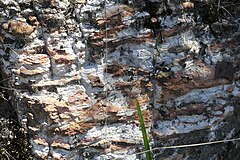| Mittagong Formation | |
|---|---|
Stratigraphic range: | |
 | |
| Type | Geological formation |
| Underlies | Ashfield Shale |
| Overlies | Hawkesbury sandstone |
| Thickness | up to 10 metres (30 ft) |
| Location | |
| Location | Sydney Basin |
| Country | Australia |
| Type section | |
| Region | Mittagong |
| Country | Australia |
| Thickness at type section | 15 metres |
The Mittagong Formation is a sedimentary rock unit in the Sydney Basin in eastern Australia. [1]
Formation
Laid down in the Triassic Period, it may be seen as an interval of interbedded fine-grained sandstone and shale between the Ashfield Shale (above) and the Hawkesbury sandstone (below). The maximum thickness around Sydney may be ten metres. [2] Near Town Hall railway station, the formation is 8 metres thick. In the type area at Mittagong it is 15 metres thick.
Whereabouts
In northern Sydney it can be seen in several areas, such as West Pymble [3] and Mount Ku-ring-gai. [4] This rock formation is associated with the critically endangered Sydney Turpentine-Ironbark Forest. [5]
See also
References
- ^ "Australian Museum - The Sydney Basin".
- ^ "Geoscience Australia".
- ^ Field Geology of New South Wales, Sydney Basin page 102
- ^ Chris Herbert. Geology of the Sydney 1:100,000 Sheet 9130
- ^ "Sydney Turpentine-Ironbark Forest".
| Mittagong Formation | |
|---|---|
Stratigraphic range: | |
 | |
| Type | Geological formation |
| Underlies | Ashfield Shale |
| Overlies | Hawkesbury sandstone |
| Thickness | up to 10 metres (30 ft) |
| Location | |
| Location | Sydney Basin |
| Country | Australia |
| Type section | |
| Region | Mittagong |
| Country | Australia |
| Thickness at type section | 15 metres |
The Mittagong Formation is a sedimentary rock unit in the Sydney Basin in eastern Australia. [1]
Formation
Laid down in the Triassic Period, it may be seen as an interval of interbedded fine-grained sandstone and shale between the Ashfield Shale (above) and the Hawkesbury sandstone (below). The maximum thickness around Sydney may be ten metres. [2] Near Town Hall railway station, the formation is 8 metres thick. In the type area at Mittagong it is 15 metres thick.
Whereabouts
In northern Sydney it can be seen in several areas, such as West Pymble [3] and Mount Ku-ring-gai. [4] This rock formation is associated with the critically endangered Sydney Turpentine-Ironbark Forest. [5]
See also
References
- ^ "Australian Museum - The Sydney Basin".
- ^ "Geoscience Australia".
- ^ Field Geology of New South Wales, Sydney Basin page 102
- ^ Chris Herbert. Geology of the Sydney 1:100,000 Sheet 9130
- ^ "Sydney Turpentine-Ironbark Forest".